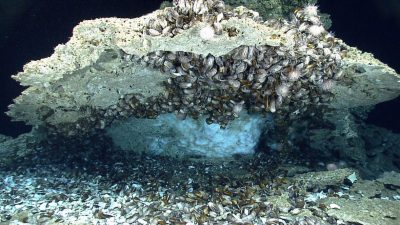Swapping CO2 for Energy
November 12, 2019

Climate change and energy supply are two of the biggest challenges humans are facing. A new approach for extracting natural gas that also traps carbon dioxide deep underground in the process could help on both fronts.
The approach was developed by researchers at The University of Texas at Austin and works by injecting air and carbon dioxide (CO2) into methane ice deposits. This triggers a process in which nitrogen in the injected air sweeps the methane toward a production well. The carbon dioxide replaces the departed methane.
A study published June 27, 2019, in the journal Water Resources Research used computer models to simulate the chemical swap, which could help unlock vast natural gas energy deposits locked away in deposits of methane hydrate — an ice-like, water-rich chemical compound that forms naturally in high-pressure, low-temperature environments, such as deep in the Gulf of Mexico and under Arctic permafrost.
“Our study shows that you can store carbon dioxide in hydrates and produce energy at the same time,” said lead author Kris Darnell, a recent doctoral graduate from the UT Jackson School of Geosciences.
This is not the first time that hydrate deposits have been proposed for carbon dioxide storage. Earlier attempts either failed or produced lackluster results. The new study breaks down the physics behind the process to reveal why previous attempts failed and how to get it right.
The next step, said Darnell, is to test their findings in a lab. The Jackson School and the UT Hildebrand Department of Petroleum and Geosystems Engineering are currently testing the method in a specialized facility in the Jackson School, which is one of the few in the world that can store and test methane hydrate. This work is being led by Peter Flemings, a Jackson School professor and senior research scientist at the Institute for Geophysics, and David DiCarlo, a professor in the Hildebrand Department.
“Two things are really cool. First, we can produce natural gas to generate energy and sequester CO2,” Flemings said. “Second, by swapping the methane hydrate with CO2 hydrate, we disturb the [geologic] formation less, lowering the environmental impact, and we make the process energetically more efficient.”
If the process can be shown to work in the field on an industrial scale, it has enormous potential. Estimates suggest that methane harvested from hydrate deposits found beneath the Gulf of Mexico alone could power the country for hundreds of years. The computer simulations indicate that the process can be repeated with increasing concentrations of carbon dioxide until the reservoir becomes saturated. The authors said that, unlike some methods of carbon storage, this provides a ready incentive for industry to begin storing carbon dioxide, a major driver of climate change.
“We’re now openly inviting the entire scientific community to go out and use what we’re learning to move the ball forward,” Flemings said.
Back to the Newsletter